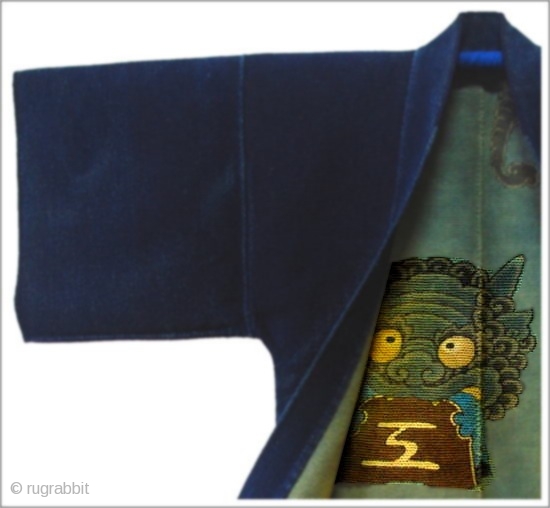Back
Hikeshi-Banten, Late 1800s
Japanese Sashiko-Sakiori Hanten Fireman's Jacket
http://www.kimonoboy.com/catalog.html?category=boro-kimonos
Called Hikeshi-banten in Japanese, a fireman's jacket is a several fabric layered handmade garment fashioned from highly absorbent cotton fabric. Before the fireman began fighting the fire, his jacket was drenched with water. The jacket's thick padding of fabric layers allowed for maximum water penetration and cushioning which helped to safeguard the fireman from burns and blunt the harmful impact of falling objects.
The exterior layer is fashioned from sakiori weaving while the liner fabric shows detailed close rows of binding sashiko stitching (descriptions of these features can be found in our Japanese Textile History in the upper menu). The firemen also wore protective hats, gloves and pants which were constructed in the same manner as the jacket, in all the fireman's suit .
This hikeshi-banten is decorated with marvelous tsutsugaki symbolic images that are meaningful and important to the firefighter.
The jacket is reversible. While fighting fires the plain side would be exposed. After the fire had been extinguished, the fireman would reverse his jacket and the decorative images would be displayed to cheering onlookers, pridefully symbolizing the successful outcome.
The fireman’s objective was to prevent a burning house from spreading its flames onward to the surrounding dwellings. The greatest danger was that when a house caught fire in the densely populated cities, the flames would quickly spread to the neighboring residences. This meant that the fireman's task was not save the home in flame, but rather to tear down the burning structure and extinguish the fire. He worked with long poles and other fire implements to demolish the blazing house. Once the fire had been doused, the surrounding homes were once again safe. Most structures of the time were vulnerable to fires because they were lightly constructed of wood and paper.
- Home
- Antique Rugs by Region
- Category
- Profiles
- Post Items Free
- Albums
- Benaki Museum of Islamic Art
- Budapest: Ottoman Carpets
- Gulbenkian Museum
- Islamic Carpets. Brooklyn
- Islamic Textiles. Brooklyn
- Konya Museum: Rugs
- MKG, Hamburg
- MMA: Caucasian Carpets
- MMA: Mamluk Carpets
- MMA: Mughal Indian Carpets
- MMA: Ottoman Carpets
- MMA: Safavid Persian Carpets
- MMA: Turkmen Rugs
- McCoy Jones Kilims
- Ottoman textiles. Met
- Philadelphia Museum
- Rugs and Carpets: Berlin
- Seljuqs at the Met
- TIEM, Istanbul: Carpets
- V&A: Classical Carpets
- Vakiflar Carpets: Istanbul
- Baluch Rugs: Indianapolis
- Gallery Exhibitions
- Jaf an Exhibition
- Alberto Levi Gallery
- Andean Textile
- Christie's London: 2016
- Francesca Galloway
- HALI at 40
- ICOC Washington, DC 2018
- Jajims of the Shahsavan
- London Islamic Week April, 2018
- Mongolian Felts
- Navajo Rugs: JB Moore
- Persian Piled Weavings
- SF Tribal & Textile Art Show 2020
- SF Tribal 2019
- Sotheby's: C. Alexander
- Turkish Prayer Rugs
- Turkmen Main Carpets ICOC 2007








